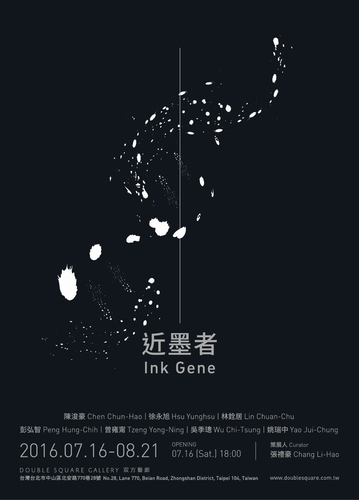Ink Gene
7/16 (Sat) - 8/21/2016 (Sun)
Chen Chun-Hao, Hsu YungHsu, Lin Chuan-Chu, Peng Hung-Chih, Tzeng Yong-Ning, Wu Chi-Tsung, Yao Jui-Chung

Dates: 2016.07.16 - 2016.08.21
Venue: Double Square Gallery
Opening: 2016.07.16 Sat. 18:00
Double Square Gallery is honored to host the joint exhibition Ink Gene to be held from 16 July to 21 August 2016. This joint exhibition features the works by seven Taiwanese contemporary artists par excellence, including Chen Chun-Hao, Hsu YungHsu, Lin Chuan-Chu, Peng Hung-Chih, Tzeng Yong-Ning, Wu Chi-Tzung, and Yao Jui-Chung. The curator of this exhibition, Chang Li-Hao, believes that the genes of every person may be much wider-spread than we thought, covering broader geographic areas and spanning over a longer period of time, no matter what his/her nation, region or race is, or whether he/she has ever set foot on foreign lands. Therefore, you, me, him or her, and people scattered in every corner of the world are, in some way, like neighbors and even relatives who share each other’s memory genes.
Since ancient times, Taiwan has absorbed the genes of Pingpu tribe, Baiyue tribe, Austronesian peoples, Han people, and even Dutch, Spanish, Portuguese, which in turn nurtured a diversified and rich culture. The dominant influences of the Han culture over the past several hundred years have particularly made the traditional Chinese aesthetics an unavoidable issue for creators in Taiwan. According to the observations of the curator, this “orthodoxy” has experienced many external impacts since the lifting of Martial Law in the 1990s, which ultimately caused the mutation of its cultural genes. Ink painting has been subjected to in-depth reviews and challenges in terms of themes, ideologies, media and materials, ergo engendering or inducing the concept of “Chinese traditions as the essence and local art forms as practical application.” This methodology for art exploration is completely different from the “Celestial Empire aesthetics” that China has eagerly wished to reconstruct since the 10-year disaster of Cultural Revolution, with the aim of contending against the Western aesthetics.